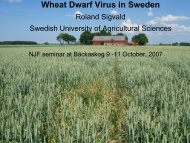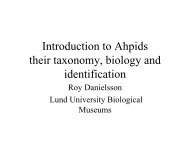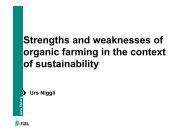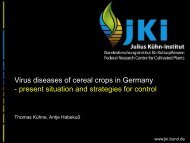measurement methods of soil, water, plant and fruit, in berry ... - NJF
measurement methods of soil, water, plant and fruit, in berry ... - NJF
measurement methods of soil, water, plant and fruit, in berry ... - NJF
You also want an ePaper? Increase the reach of your titles
YUMPU automatically turns print PDFs into web optimized ePapers that Google loves.
LEAF- OR SAP ANALYSIS ?<br />
A comparison <strong>of</strong> strong <strong>and</strong> weak po<strong>in</strong>ts<br />
Ingemar Månsson,<br />
LMI AB, Sweden.<br />
Abstract<br />
Leaf analysis is compared with Sap analysis on general pr<strong>in</strong>ciples. The second half <strong>of</strong> the<br />
article is a subjective evaluation <strong>of</strong> strong <strong>and</strong> weak po<strong>in</strong>ts based on 55 years <strong>of</strong> experience.<br />
Background<br />
In all <strong>plant</strong>s nutrients are present <strong>in</strong> 2 forms. Partly as dissolved <strong>in</strong>organic salts, these are raw<br />
material necessary for further growth. Partly as organic products such as prote<strong>in</strong>s, chlorophyll<br />
<strong>and</strong> enzymes.<br />
The conventional leaf-analysis measures everyth<strong>in</strong>g <strong>in</strong> the sample, both raw material <strong>and</strong><br />
f<strong>in</strong>ished products. Results are given / kg dry matter.<br />
Sap analysis measures only the raw material <strong>and</strong> results are given as mg/l.<br />
60<br />
50<br />
40<br />
30<br />
20<br />
10<br />
0<br />
Leaf analysis<br />
% or mg/l, does it matter?<br />
Plant material conta<strong>in</strong>s vary<strong>in</strong>g amounts <strong>of</strong> sugar, starch <strong>and</strong> cellulose. These carbohydrates<br />
do not conta<strong>in</strong> <strong>plant</strong> nutrients, but they affect the weight <strong>of</strong> the dry sample.<br />
The practical effect <strong>of</strong> this is that leaf analysis will show lower nutrient levels as<br />
carbohydrates <strong>in</strong>crease. Normally carbohydrate content <strong>in</strong>creases with age, why<br />
optimumlevels <strong>of</strong> nutrients will change drastically dur<strong>in</strong>g the year. This effect is so strong that<br />
it is necessary to strict regulate what parts are to be sampled, also the developementstage has<br />
to be <strong>in</strong>cluded <strong>in</strong> order to evaluate the result. To get reliable references <strong>in</strong>volves a lot <strong>of</strong><br />
analysis <strong>and</strong> work. Specific references for different varieties might be necessary.<br />
Sap analysis is not affected by above variations. Differences <strong>in</strong> reference values between<br />
varieties are rare.<br />
Total content or raw material ?<br />
OPTIMUM VALUES<br />
Sap analysis<br />
1 2 3 4 5 6 7 8 9 10 11 12 13 14 15 16 17 18 19 20 21 22 23 24 25 26 27 28 29 30 31 32 33 34 35 36 37 38 39









